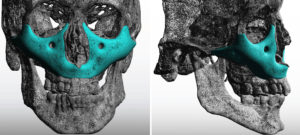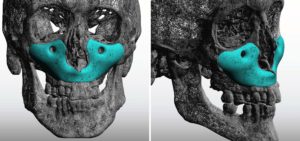The effectiveness of standard facial implants is based on their ability to improve the natural convexities of the facial bones. The bony projections of the chin, jaw angles and cheeks make up the majority of available facial implant types. These three prominences make up the important bony triangle of the face which together make a major contribution to its appearance.
But not all facial augmentations are to improve convexities, some are to change the shape of a concavity. Such facial areas for implants are less recognized but can be augmented nonetheless. The midface is the largest concavity of the face and lies between the more prominent infraorbital rim superior and the maxillary alveolus inferiorly. It has a completely concave shape due to the underlying maxillary sinus and transmits masticatory forces through its somewhat thicker buttresses.
The only standard alloplastic midface method is that of the paranasal implant. Its purpose is to provide improved projection to the overlying base of the nose. It is one of the smallest facial implants and its midface effect is limited.


Dr. Barry Eppley
Indianapolis, Indiana



